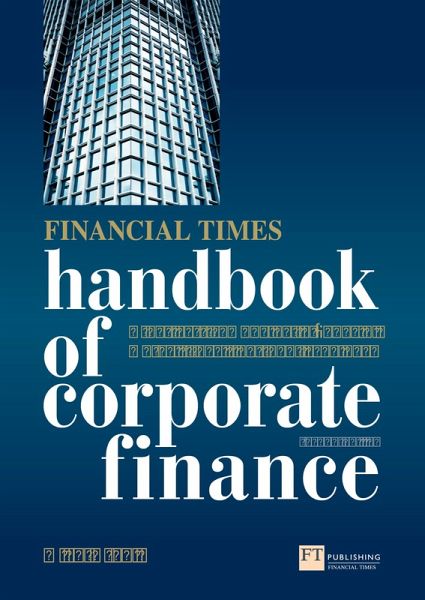
Financial Times Handbook of Corporate Finance, The
A Business Companion to Financial Markets, Decisions and Techniques
Versandkostenfrei!
Nicht lieferbar
Weitere Ausgaben:
Mangers working in business find that the further they progress, the more they need to understand the concepts and jargon of the business world.
This book introduces the principles and practices of corporate finance and the financial markets. It identifies the following key financial knowledge that the reader will require:
An explanation of value-based management.
Mergers and the problem of merger failures.
The use of derivatives in helping businesses control risk.
Investment appraisal techniques.
How the financial markets work.
Enhancing shareholder value.
Raising capital for your company.
Product Description
The Financial Times Handbook of Corporate Finance is the authoritative introduction to the principles and practices of corporate finance and the financial markets. Whether you are an experienced manager or finance officer, or youre new to financial decision making, this handbook identifies all those things that you really need to know:
· An explanation of value-based management
· Mergers and the problem of merger failures
· Investment appraisal techniques
· How to enhance shareholder value
· How the finance and money markets really work
· Controlling foreign exchange rate losses
· How to value a company
The second edition of this bestselling companion to finance has been thoroughly updated to ensure that your decisions continue to be informed by sound business principles. New sections include corporate governance, the impact of taxation on investment strategies, using excess return as a new value metric, up-to-date statistics which reflect the latest returns on shares, bonds and merger activities and a jargon-busting glossary to help you understand words, phrases and concepts.
Corporate finance touches every aspect of your business, from deciding which capital expenditure projects are worth backing, through to the immediate and daily challenge of share holder value, raising finance or managing risk.
The Financial Times Handbook of Corporate Finance will help you and your business back the right choices, make the right decisions and deliver improved financial performance. It covers the following areas:
· Evaluating your firms objectives
· Assessment techniques for investment
· Traditional finance appraisal techniques
· Investment decision-making in companies
· Shareholder value
· Value through strategy
· The cost of capital
· Mergers: failures and success
· Merger processes
· How to value companies
· Pay outs to shareholders
· Debt finance
· Raising equity capital
· Managing risk
· Options
· Futures, forwards and swaps
· Exchange rate risk
Backcover
The Financial Times Handbook of Corporate Finance is the authoritative introduction to the principles and practices of corporate finance and the financial markets. Whether you are an experienced manager or finance officer, or youre new to financial decision making, this handbook identifies all those things that you really need to know:
· An explanation of value-based management
· Mergers and the problem of merger failures
· Investment appraisal techniques
· How to enhance shareholder value
· How the finance and money markets really work
· Controlling foreign exchange rate losses
· How to value a company
The second edition of this bestselling companion to finance has been thoroughly updated to ensure that your decisions continue to be informed by sound business principles. New sections include corporate governance, the impact of taxation on investment strategies, using excess return as a new value metric, up-to-date statistics which reflect the latest returns on shares, bonds and merger activities and a jargon-busting glossary to help you understand words, phrases and concepts.
Table of Contents
CONTENTS
Introduction
· Some of the financial issues covered
· The scope of corporate finance
Chapter 1. What is the firms objective?
A common purpose
The assumed objective of finance
Why should we aim for shareholder wealth?
What is shareholder wealth?
Profit maximisation is not the same as shareholder wealth maximisation
Getting managers objectives aligned with shareholders objectives
What happens if control over directors is weak?
Conclusion
PART 1 IINVESTING IN PROJECTS?
Chapter 2. State-of-the-art project assessment techniques
How do you know whether an investment generates value for shareholders?
State-of-the-art technique 1: net present value
State-of-the-art technique 2: internal rate of return
Choosing between NPV and IRR
Appendix 2.1 Mathematical tools for finance
Chapter 3. Traditional appraisal techniques
What appraisal techniques businesses actually use
Payback
Accounting rate of return
Internal rate of return: reason for continued popularity
Chapter 4. Investment decision-making in companies
The managerial art of investment selection
More tricky issues in real world project appraisal
The stages of investment decision making
Chapter 5. Allowing for risk in project appraisal
What is risk?
Adjusting for risk through the discount rate
Sensitivity analysis
Scenario analysis
Probability analysis
Problems with using probability analysis
Evidence of risk analysis in practice
PART 2 SHAREHOLDER VALUE
Chapter 6. Value managed companies versus earnings managed companies
The pervasiveness of the value approach
Case studies: FT100 companies creating value and destroying value
Why shareholder value?
Three steps to value
Earnings-based managements failings
ROCE has failings
Focusing on earnings is not the same as value
How a business creates value
The five actions to create value
Chapter 7. Value through strategy
Value principles touch every corner of the business
Strategic business unit management
The firms objective
Strategic assessment
Strategic choice
Strategy implementation
What use is the head office?
Targets and motivation
Chapter 8. Value creation within strategic business units
· Using cash flow to measure value
· Shareholder value analysis
· Economic profit
· Economic value added (EVA)
· Cash flow return on investment
Chapter 9. Entire firm value measurement
Total shareholder return
Wealth added index
Market added value
Market to book ratio
Chapter 10. What is the companys cost of capital?
A word of warning
The required rate of return
Two sides of the same coin
The weighted average cost of capital
The cost of equity capital
The cost of retained earnings
Debt capital
The cost of preference share capital
Hybrid securities
Calculating the weights
The WACC with three or more types of finance
Classic error
What do mangers actually do?
Implementation issues
Which risk-free rate
Fundamental beta
Chapter 11. Mergers: impulse, regret and success
The merger decision
You say merger, I say acquisition
Merger statistics
What drives firms to merge?
Do the shareholders of acquiring firms gain from mergers?
Managing mergers
Chapter 12. The merger process
The City code on takeovers and mergers
Action before the bid
The bid
After the bid
Defence tactics
Paying for the targets shares: cash or shares?
Chapter 13. Valuing companies
The two skills
Valuation using net asset value
Income flow is the key
Dividend valuation methods
How do you estimate future growth?
Price-earnings ratio methods
Valuation using cash flow
Valuing unquoted shares
Unusual companies
Managerial control changes the valuation
Chapter 14. What pay-outs should we make to shareholders?
Defining the problem
Theorists in their hypothetical world
The other extreme dividends as residual
What about the world in which we live?
Some muddying factors
Scrip dividends
Share buy-backs and special dividends
A round-up of the arguments
PART 3 FINANCE RAISING
Chapter 15. Debt finance available to firms of all sizes
Contrasting debt finance with equity
Bank borrowing
Overdraft
Trade credit
Factoring
Hire purchase
Leasing
Bills of exchange
Acceptance credits
Chapter 16. Debt finance from the financial markets
Bonds
Syndicated loans
Credit ratings
Mezzanine debt and high yield debt
Convertible bonds
Valuing bonds
International sources of debt finance
Medium-term notes
Commercial paper
Project finance
Sales and leaseback
Securitization
Chapter 17. Raising equity capital
What is equity capital?
Preference shares
Floating on the Official List
What manager need to consider
Methods of issue
Timetable of a new offer
How does flotation on AIM differ
The cost of new issues
Rights issues
Other equity issues
Scrip issues
Warrants
Equity finance for unquoted firms
Disillusionment and dissatisfaction with quotation
Appendix - Arguments for and against flotation
PART 4 MANAGING RISK
Chapter 18. The financial risks managers have to deal with
Types of risk
Risk in the financial structure
The dangers of gearing
What do we mean by gearing?
Agency costs
Pecking order
Some further thoughts on debt finance
Chapter 19. Options
What is a derivative
A long history
What is an option
Share options
Index options
Corporate uses of options
Real options
Chapter 20. Using futures, forwards and swaps to manage risk
Futures
Short-term interest rate futures
Forwards
Forward agreements
A comparison of options, futures and FRAs
Caps
Swaps
Derivative users
Over-the-counter and exchange traded derivatives
Chapter 21. Managing exchange rate risk
The impact
This book introduces the principles and practices of corporate finance and the financial markets. It identifies the following key financial knowledge that the reader will require:
An explanation of value-based management.
Mergers and the problem of merger failures.
The use of derivatives in helping businesses control risk.
Investment appraisal techniques.
How the financial markets work.
Enhancing shareholder value.
Raising capital for your company.
Product Description
The Financial Times Handbook of Corporate Finance is the authoritative introduction to the principles and practices of corporate finance and the financial markets. Whether you are an experienced manager or finance officer, or youre new to financial decision making, this handbook identifies all those things that you really need to know:
· An explanation of value-based management
· Mergers and the problem of merger failures
· Investment appraisal techniques
· How to enhance shareholder value
· How the finance and money markets really work
· Controlling foreign exchange rate losses
· How to value a company
The second edition of this bestselling companion to finance has been thoroughly updated to ensure that your decisions continue to be informed by sound business principles. New sections include corporate governance, the impact of taxation on investment strategies, using excess return as a new value metric, up-to-date statistics which reflect the latest returns on shares, bonds and merger activities and a jargon-busting glossary to help you understand words, phrases and concepts.
Corporate finance touches every aspect of your business, from deciding which capital expenditure projects are worth backing, through to the immediate and daily challenge of share holder value, raising finance or managing risk.
The Financial Times Handbook of Corporate Finance will help you and your business back the right choices, make the right decisions and deliver improved financial performance. It covers the following areas:
· Evaluating your firms objectives
· Assessment techniques for investment
· Traditional finance appraisal techniques
· Investment decision-making in companies
· Shareholder value
· Value through strategy
· The cost of capital
· Mergers: failures and success
· Merger processes
· How to value companies
· Pay outs to shareholders
· Debt finance
· Raising equity capital
· Managing risk
· Options
· Futures, forwards and swaps
· Exchange rate risk
Backcover
The Financial Times Handbook of Corporate Finance is the authoritative introduction to the principles and practices of corporate finance and the financial markets. Whether you are an experienced manager or finance officer, or youre new to financial decision making, this handbook identifies all those things that you really need to know:
· An explanation of value-based management
· Mergers and the problem of merger failures
· Investment appraisal techniques
· How to enhance shareholder value
· How the finance and money markets really work
· Controlling foreign exchange rate losses
· How to value a company
The second edition of this bestselling companion to finance has been thoroughly updated to ensure that your decisions continue to be informed by sound business principles. New sections include corporate governance, the impact of taxation on investment strategies, using excess return as a new value metric, up-to-date statistics which reflect the latest returns on shares, bonds and merger activities and a jargon-busting glossary to help you understand words, phrases and concepts.
Table of Contents
CONTENTS
Introduction
· Some of the financial issues covered
· The scope of corporate finance
Chapter 1. What is the firms objective?
A common purpose
The assumed objective of finance
Why should we aim for shareholder wealth?
What is shareholder wealth?
Profit maximisation is not the same as shareholder wealth maximisation
Getting managers objectives aligned with shareholders objectives
What happens if control over directors is weak?
Conclusion
PART 1 IINVESTING IN PROJECTS?
Chapter 2. State-of-the-art project assessment techniques
How do you know whether an investment generates value for shareholders?
State-of-the-art technique 1: net present value
State-of-the-art technique 2: internal rate of return
Choosing between NPV and IRR
Appendix 2.1 Mathematical tools for finance
Chapter 3. Traditional appraisal techniques
What appraisal techniques businesses actually use
Payback
Accounting rate of return
Internal rate of return: reason for continued popularity
Chapter 4. Investment decision-making in companies
The managerial art of investment selection
More tricky issues in real world project appraisal
The stages of investment decision making
Chapter 5. Allowing for risk in project appraisal
What is risk?
Adjusting for risk through the discount rate
Sensitivity analysis
Scenario analysis
Probability analysis
Problems with using probability analysis
Evidence of risk analysis in practice
PART 2 SHAREHOLDER VALUE
Chapter 6. Value managed companies versus earnings managed companies
The pervasiveness of the value approach
Case studies: FT100 companies creating value and destroying value
Why shareholder value?
Three steps to value
Earnings-based managements failings
ROCE has failings
Focusing on earnings is not the same as value
How a business creates value
The five actions to create value
Chapter 7. Value through strategy
Value principles touch every corner of the business
Strategic business unit management
The firms objective
Strategic assessment
Strategic choice
Strategy implementation
What use is the head office?
Targets and motivation
Chapter 8. Value creation within strategic business units
· Using cash flow to measure value
· Shareholder value analysis
· Economic profit
· Economic value added (EVA)
· Cash flow return on investment
Chapter 9. Entire firm value measurement
Total shareholder return
Wealth added index
Market added value
Market to book ratio
Chapter 10. What is the companys cost of capital?
A word of warning
The required rate of return
Two sides of the same coin
The weighted average cost of capital
The cost of equity capital
The cost of retained earnings
Debt capital
The cost of preference share capital
Hybrid securities
Calculating the weights
The WACC with three or more types of finance
Classic error
What do mangers actually do?
Implementation issues
Which risk-free rate
Fundamental beta
Chapter 11. Mergers: impulse, regret and success
The merger decision
You say merger, I say acquisition
Merger statistics
What drives firms to merge?
Do the shareholders of acquiring firms gain from mergers?
Managing mergers
Chapter 12. The merger process
The City code on takeovers and mergers
Action before the bid
The bid
After the bid
Defence tactics
Paying for the targets shares: cash or shares?
Chapter 13. Valuing companies
The two skills
Valuation using net asset value
Income flow is the key
Dividend valuation methods
How do you estimate future growth?
Price-earnings ratio methods
Valuation using cash flow
Valuing unquoted shares
Unusual companies
Managerial control changes the valuation
Chapter 14. What pay-outs should we make to shareholders?
Defining the problem
Theorists in their hypothetical world
The other extreme dividends as residual
What about the world in which we live?
Some muddying factors
Scrip dividends
Share buy-backs and special dividends
A round-up of the arguments
PART 3 FINANCE RAISING
Chapter 15. Debt finance available to firms of all sizes
Contrasting debt finance with equity
Bank borrowing
Overdraft
Trade credit
Factoring
Hire purchase
Leasing
Bills of exchange
Acceptance credits
Chapter 16. Debt finance from the financial markets
Bonds
Syndicated loans
Credit ratings
Mezzanine debt and high yield debt
Convertible bonds
Valuing bonds
International sources of debt finance
Medium-term notes
Commercial paper
Project finance
Sales and leaseback
Securitization
Chapter 17. Raising equity capital
What is equity capital?
Preference shares
Floating on the Official List
What manager need to consider
Methods of issue
Timetable of a new offer
How does flotation on AIM differ
The cost of new issues
Rights issues
Other equity issues
Scrip issues
Warrants
Equity finance for unquoted firms
Disillusionment and dissatisfaction with quotation
Appendix - Arguments for and against flotation
PART 4 MANAGING RISK
Chapter 18. The financial risks managers have to deal with
Types of risk
Risk in the financial structure
The dangers of gearing
What do we mean by gearing?
Agency costs
Pecking order
Some further thoughts on debt finance
Chapter 19. Options
What is a derivative
A long history
What is an option
Share options
Index options
Corporate uses of options
Real options
Chapter 20. Using futures, forwards and swaps to manage risk
Futures
Short-term interest rate futures
Forwards
Forward agreements
A comparison of options, futures and FRAs
Caps
Swaps
Derivative users
Over-the-counter and exchange traded derivatives
Chapter 21. Managing exchange rate risk
The impact
Mangers working in business find that the further they progress, the more they need to understand the concepts and jargon of the business world. This book introduces the principles and practices of corporate finance and the financial markets. It identifies the following key financial knowledge that the reader will require: . An explanation of value-based management. . Mergers and the problem of merger failures. . The use of derivatives in helping businesses control risk. . Investment appraisal techniques. . How the financial markets work. . Enhancing shareholder value. . Raising capital for your company.














